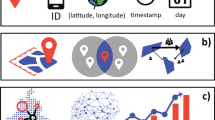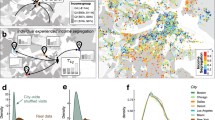Abstract
Amid rising congestion and transport emissions, policymakers are embracing the ‘15-minute city’ model, which envisions neighbourhoods where basic needs can be met within a short walk from home. Prior research has primarily examined amenity access without exploring its relationship to behaviour. We introduce a measure of local trip behaviour using GPS data from 40 million US mobile devices, defining ‘15-minute usage’ as the proportion of consumption-related trips made within a 15-minute walk from home. Our findings show that the median resident makes only 14% of daily consumption trips locally. Differences in access to local amenities can explain 84% and 74% of the variation in 15-minute usage across and within urban areas, respectively. Historical data from New York zoning policies suggest a causal relationship between local access and 15-minute usage. However, we find a trade-off: increased local usage correlates with higher experienced segregation for low-income residents, signalling potential socio-economic challenges in achieving local living.
This is a preview of subscription content, access via your institution
Access options
Access Nature and 54 other Nature Portfolio journals
Get Nature+, our best-value online-access subscription
$29.99 / 30 days
cancel any time
Subscribe to this journal
Receive 12 digital issues and online access to articles
$119.00 per year
only $9.92 per issue
Buy this article
- Purchase on Springer Link
- Instant access to full article PDF
Prices may be subject to local taxes which are calculated during checkout






Similar content being viewed by others
Data availability
The main dataset of mobile device locations was obtained from SafeGraph. The authors do not have permission to share these data. Source data are provided with this paper.
Code availability
The code to replicate the results in the paper can be obtained from the authors upon request.
Change history
02 April 2024
A Correction to this paper has been published: https://doi.org/10.1038/s41562-024-01874-z
References
Generating Power (United Nations, accessed 19 January 2023); https://www.un.org/en/climatechange/climate-solutions/cities-pollution
World Population Prospects (Department of Economic and Social Affairs, United Nations, 2019).
Griggs, D. et al. Sustainable development goals for people and planet. Nature 495, 305–307 (2013).
International Energy Outlook 2021 (US Energy Information Administration, 2021); https://www.eia.gov/outlooks/ieo/pdf/IEO2021_ReleasePresentation.pdf
Fast Facts on Transportation Greenhouse Gas Emissions (US Environmental Protection Agency, 2020); https://www.epa.gov/greenvehicles/fast-facts-transportation-greenhouse-gas-emissions
Allam, Z., Bibri, S. E., Chabaud, D. & Moreno, C. The ‘15-Minute City’ concept can shape a net-zero urban future. Humanit. Soc. Sci. Commun. 9, 126 (2022).
Moreno, C., Allam, Z., Chabaud, D., Gall, C. & Pratlong, F. Introducing the ‘15-minute city’: sustainability, resilience and place identity in future post-pandemic cities. Smart Cities 4, 93–111 (2021).
Bertaud, A. Last Utopia: The 15-Minute City (Urban Reform Institute, 2022); https://urbanreforminstitute.org/wp-content/uploads/2022/02/15mincity-bertaud.pdf
Graells-Garrido, E., Serra-Burriel, F., Rowe, F., Cucchietti, F. M. & Reyes, P. A city of cities: measuring how 15-minutes urban accessibility shapes human mobility in Barcelona. PLoS ONE 16, e0250080 (2021).
Calafiore, A., Dunning, R., Nurse, A. & Singleton, A. The 20-minute city: an equity analysis of Liverpool city region. Transp. Res. D 102, 103111 (2022).
Gaxiola-Beltrán, A. L. et al. Assessing urban accessibility in Monterrey, Mexico: a transferable approach to evaluate access to main destinations at the metropolitan and local levels. Appl. Sci. 11, 7519 (2021).
Da Silva, D. C., King, D. A. & Lemar, S. Accessibility in practice: 20-minute city as a sustainability planning goal. Sustainability 12, 129 (2019).
Willberg, E., Fink, C. & Toivonen, T. The 15-minute city for all? Measuring individual and temporal variations in walking accessibility. J. Transp. Geogr. 106, 103521 (2023).
Scott, D. & Horner, M. Examining the role of urban form in shaping people’s accessibility to opportunities: an exploratory spatial data analysis. J. Transp. Land Use https://doi.org/10.5198/jtlu.v1i2.25 (2008).
Chatman, D. G. Residential choice, the built environment, and nonwork travel: evidence using new data and methods. Environ. Plan. A 41, 1072–1089 (2009).
Pyrialakou, V. D., Gkritza, K. & Fricker, J. D. Accessibility, mobility, and realized travel behavior: assessing transport disadvantage from a policy perspective. J. Transp. Geogr. 51, 252–269 (2016).
Glaeser, E. The 15-minute city is a dead end—cities must be places of opportunity for everyone. LSE COVID-19 Blog https://blogs.lse.ac.uk/covid19/2021/05/28/the-15-minute-city-is-a-dead-end-cities-must-be-places-of-opportunity-for-everyone/ (2021).
Kraemer, M. U. G. et al. Mapping global variation in human mobility. Nat. Hum. Behav. 4, 800–810 (2020).
Alessandretti, L., Sapiezynski, P., Sekara, V., Lehmann, S. & Baronchelli, A. Evidence for a conserved quantity in human mobility. Nat. Hum. Behav. 2, 485–491 (2018).
Jenny, M. A. & Betsch, C. Large-scale behavioural data are key to climate policy. Nat. Hum. Behav. 6, 1444–1447 (2022).
Needell, Z. A., McNerney, J., Chang, M. T. & Trancik, J. E. Potential for widespread electrification of personal vehicle travel in the United States. Nat. Energy 1, 16112 (2016).
Böhm, M., Nanni, M. & Pappalardo, L. Gross polluters and vehicle emissions reduction. Nat. Sustain. 5, 1–9 (2022).
Athey, S., Ferguson, B., Gentzkow, M. & Schmidt, T. Estimating experienced racial segregation in US cities using large-scale GPS data. Proc. Natl Acad. Sci. USA 118, e2026160118 (2021).
Wang, Q., Phillips, N. E., Small, M. L. & Sampson, R. J. Urban mobility and neighborhood isolation in America’s 50 largest cities. Proc. Natl Acad. Sci. USA 115, 7735–7740 (2018).
Xu, Y., Belyi, A., Santi, P. & Ratti, C. Quantifying segregation in an integrated urban physical-social space. J. R. Soc. Interface 16, 20190536 (2019).
Moro, E., Calacci, D., Dong, X. & Pentland, A. Mobility patterns are associated with experienced income segregation in large US cities. Nat. Commun. 12, 4633 (2021).
Federal Highway Administration National Household Travel Survey (US Department of Transportation, 2017); https://nhts.ornl.gov
Bereitschaft, B. Do socially vulnerable urban populations have access to walkable, transit-accessible neighborhoods? A nationwide analysis of large US metropolitan areas. Urban Sci. 7, 6 (2023).
Pucher, J. & Renne, J. L. Socioeconomics of urban travel: evidence from the 2001 NHTS. Transp. Q. 57, 49–77 (2003).
Martynov, P. Welfare Effects of Zoning: Density Restrictions and Heterogeneous Spillovers Working Paper (University of California, Berkeley, 2022).
Twinam, T. Danger zone: land use and the geography of neighborhood crime. J. Urban Econ. 100, 104–119 (2017).
Shertzer, A., Twinam, T. & Walsh, R. P. Zoning and the economic geography of cities. J. Urban Econ. 105, 20–39 (2018).
Glaeser, E. L. & Kahn, M. E. The greenness of cities: carbon dioxide emissions and urban development. J. Urban Econ. 67, 404–418 (2010).
Moreno, C. & Veltz, P. The ‘15-Minute City’: The Way Forward or an Ideological Mirage? (Forum Vies Mobiles, 2022).
Kain, J. F. Housing segregation, Negro employment, and metropolitan decentralization. Q. J. Econ. 82, 175–197 (1968).
Chetty, R. et al. Social capital I: measurement and associations with economic mobility. Nature 1–14 (2022).
Barrington-Leigh, C. & Millard-Ball, A. The world’s user-generated road map is more than 80% complete. PLoS ONE 12, e0180698 (2017).
Zielstra, D., Hochmair, H. H. & Neis, P. Assessing the effect of data imports on the completeness of OpenStreetMap—a United States case study. Trans. GIS 17, 315–334 (2013).
Li, Z., Ning, H., Jing, F. & Lessani, M. N. Understanding the bias of mobile location data across spatial scales and over time: a comprehensive analysis of SafeGraph data in the United States. Preprint at ResearchGate https://www.researchgate.net/publication/369087412_Understanding_the_bias_of_mobile_location_data_across_spatial_scales_and_over_time_a_comprehensive_analysis_of_SafeGraph_data_in_the_United_States (2023).
Squire, R. F. What about bias in the SafeGraph dataset? (Medium 2019).
Taylor, P. Smartphone Penetration Rate as Share of the Population in the United States from 2010 to 2021 Technical Report (Statista, 2023); https://www.statista.com/statistics/201183/forecast-of-smartphone-penetration-in-the-us/
Chetty, R., Friedman, J. N., Hendren, N., Jones, M. R. & Porter, S. R. The Opportunity Atlas: Mapping the Childhood Roots of Social Mobility Working Paper No. 25147 (National Bureau of Economic Research, 2018); http://www.nber.org/papers/w25147
Acknowledgements
This research was supported by grant no. 69A3552348325 from the Center for Climate-Smart Transportation to T.A., C.H., S.S., A.S.-M., P.S. and C.R. We also thank Dubai Future Foundation, UnipolTech, Consiglio per la Ricerca in Agricoltura e l’Analisi dell’Economia Agraria, Volkswagen Group America, FAE Technology, Samoo Architects & Engineers, Shell, GoAigua, ENEL Foundation, Kyoto University, Weizmann Institute of Science, Universidad Autónoma de Occidente, Instituto Politecnico Nacional, Imperial College London, Universitá di Pisa, KTH Royal Institute of Technology, AMS Institute and all the members of the MIT Senseable City Lab Consortium for supporting this research. The funders had no role in study design, data collection and analysis, decision to publish or preparation of the manuscript.
Author information
Authors and Affiliations
Contributions
T.A., E.G., C.H., S.S., A.S.-M., P.S. and C.R. designed the research. T.A., C.H., S.S. and A.S.-M. conducted the data processing and performed the analysis. T.A., E.G., C.H., S.S. and A.S.-M. wrote the manuscript.
Corresponding author
Ethics declarations
Competing interests
The authors declare no competing interests.
Inclusion and ethics
All authors have agreed to all manuscript contents, the author list and its order, and the author contribution statements. Any changes to the author list after submission will be subject to approval by all authors.
Peer review
Peer review information
Nature Human Behaviour thanks Daniel Chatman, Fernando Ferreira, Qi Ryan Wang and the other, anonymous, reviewer(s) for their contribution to the peer review of this work.
Additional information
Publisher’s note Springer Nature remains neutral with regard to jurisdictional claims in published maps and institutional affiliations.
Supplementary information
Supplementary Information
Supplementary Fig. 1 and Tables 1–9.
Source data
Source Data Fig. 2
Statistical source data.
Rights and permissions
Springer Nature or its licensor (e.g. a society or other partner) holds exclusive rights to this article under a publishing agreement with the author(s) or other rightsholder(s); author self-archiving of the accepted manuscript version of this article is solely governed by the terms of such publishing agreement and applicable law.
About this article
Cite this article
Abbiasov, T., Heine, C., Sabouri, S. et al. The 15-minute city quantified using human mobility data. Nat Hum Behav 8, 445–455 (2024). https://doi.org/10.1038/s41562-023-01770-y
Received:
Accepted:
Published:
Issue Date:
DOI: https://doi.org/10.1038/s41562-023-01770-y



